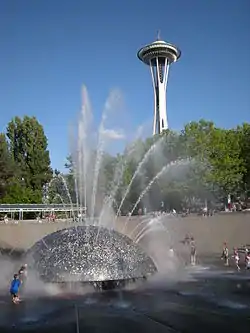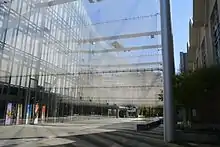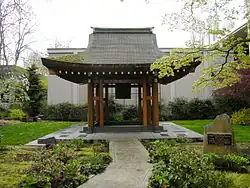
Seattle Center is an entertainment, education, tourism and performing arts center located in the Lower Queen Anne neighborhood of Seattle, Washington, United States. Constructed for the 1962 World's Fair, Seattle Center's landmark feature is the 605 ft (184 m) Space Needle, an official city landmark and globally recognized symbol of Seattle's skyline. Other notable attractions include the Pacific Science Center, Climate Pledge Arena, and Museum of Pop Culture (MoPOP), as well as McCaw Hall, which hosts both the Seattle Opera and Pacific Northwest Ballet. The Seattle Center Monorail provides regular public transit service between Seattle Center and Westlake Center in Downtown Seattle, and is itself considered a tourist attraction.


History
.gif)
.jpg.webp)
In 1886, Seattle founder David Denny donated the tract of land that would eventually host Seattle Center, stipulating that it be of "public use forever". Plans for the land took shape in 1928, when mayor Bertha Knight Landes dedicated the newly-constructed arena and auditorium on the site as the Civic Center complex. In 1958, the Civic Auditorium was chosen as the future location of the World's Fair, and demolition work began following a countdown ceremony initiated by President Dwight D. Eisenhower.
In 1961, Japanese architects Hideki Shimizu and Kazuyuki Matsushita were chosen to design the International Fountain, and a contract with Alweg Rapid Transit Systems was signed for the construction of the monorail. On April 21, 1962, President John F. Kennedy officially opened the World's Fair; the six-month event was attended by, among others, astronaut John Glenn, politician Robert F. Kennedy, and singer Elvis Presley, who arrived in September 1962 to shoot the film It Happened at the World's Fair. Following the conclusion of the event, ownership of the complex was returned to the City of Seattle, which has since maintained it as a hub for the city's performing arts and sporting events.[1]
Attractions
Several buildings and pieces of artwork at Seattle Center have Japanese influences. These include the Pacific Science Center, designed by architect Minoru Yamasaki,[2] the "Seattle Mural" by artist Paul Horiuchi, and the Kobe Bell, a gift to Seattle from its sister city of Kobe, Japan.[3]
Landmarks
- The Space Needle, an official city landmark, featuring an observation deck and revolving restaurant.[4] At the time of its completion in 1961, the Space Needle was the tallest building west of the Mississippi River.
- International Fountain, located in the center of the complex. Designed by Japanese architects Kazuyuki Matsushita and Hideki Shimizu, the fountain was built as a modernist water sculpture and renovated extensively in 1995. With over 20 spouts, the fountain rotates through programmed cycles of water patterns, accompanied by recorded music from around the world. The music is changed twice a month; it is chosen to compliment the water patterns and events programming at the center.
- John T. Williams totem pole - A 34-foot (10 m) totem pole commemorating John T. Williams.
- Kobe Bell, an official city landmark[5]
- Mural Ampitheatre, featuring a mosaic mural by artist Paul Horiuchi; the Horiuchi Mural, also created for the World's Fair, is an official city landmark.[6]
- Artists At Play playground
- Howard S. Wright Memorial Fountain
- Seattle Center Monorail
Museums
- Museum of Pop Culture (MoPOP, formerly EMP Museum)
- Chihuly Garden and Glass
- Pacific Science Center, located in the former United States Science Pavilion building designed by Minoru Yamasaki
- Seattle Children's Museum, located in the Armory
Performing arts
- Marion Oliver McCaw Hall, home of the Seattle Opera and Pacific Northwest Ballet, whose ballet school is adjacent at the Phelps Center. This is the third performance space on this site, the second being the Opera House built at the time of the World's Fair.
- Seattle Repertory Theatre, home of the Bagley Wright Theatre, the Leo Kreielsheimer Theatre, and the PONCHO Forum
- Center Theatre, home of the Seattle Shakespeare Company and Book-It Repertory Theatre
- Theatre Puget Sound
- The Center School
- Cornish Playhouse, home of productions of the Cornish College of the Arts
- Seattle Children's Theatre at the Charlotte Martin Theatre
- The Vera Project (or VERA)
- Mercer Arena, formerly a sports, concert, and opera venue before sitting vacant for several years. It was demolished and the site is being redeveloped as the future home of Seattle Opera.
Venues
- Seattle Center Armory (known as Center House[7] from the early 1970s until 2012, and the Food Circus[8] from 1962 to the early 1970s), including Center Theatre, the home of Seattle Shakespeare Company and Book-It Repertory Theatre, as well as the Seattle Children's Museum, The Center High School and the Academy of Interactive Entertainment. Before the 1962 World's Fair, the building was an armory. Seattle Center Armory is an official city landmark.[4]
- A piece of the Berlin Wall is in the food atrium.
- Exhibition Hall, a space for trade shows, receptions, exhibits, and special events
- Fisher Pavilion at Seattle Center is one of the largest rental venues on the grounds and the first City of Seattle building to achieve LEED (Leadership in Energy and Environmental Design) certification. The large, flexible space can accommodate a wide range of commercial, charity and community events.
- The Northwest Rooms, once a small conference center, now houses SIFF Film Center, The VERA Project, and KEXP-FM.
- IMAX Theater at Pacific Science Center[9]
- Seattle Laser Dome
Athletics
- Climate Pledge Arena is the current home of the Seattle University Redhawks men's basketball team, the WNBA's Seattle Storm and the NHL's Seattle Kraken. It was the home of the NBA's Seattle SuperSonics, now the Oklahoma City Thunder, and the Seattle Thunderbirds (Western Hockey League) ice hockey. Originally opened as the Seattle Center Coliseum in 1962, it was renovated in 1995 as KeyArena and rebuilt in 2020-2021 as Climate Pledge Arena. The arena hosts over 100 events per year and was the region's top live concert touring venue in 2016 (according to Venues Today magazine)
- Memorial Stadium, a high school football and soccer stadium which predates the World's Fair. It was the home of the NWSL's Seattle Reign FC from 2014 to 2018.
Festivals
Seattle Center hosts many cultural, music and arts festivals. Major attractions include:
- Bumbershoot
- Northwest Folklife
- Festál (year-long series of 24 world cultural events)
- PrideFest
- Bite of Seattle
- Winterfest
Gallery
 View of the Space Needle with the International Fountain in the foreground.
View of the Space Needle with the International Fountain in the foreground. Kreielsheimer Promenade and Marion Oliver McCaw Hall
Kreielsheimer Promenade and Marion Oliver McCaw Hall Monorail tracks entering the Museum of Pop Culture (MoPOP) building.
Monorail tracks entering the Museum of Pop Culture (MoPOP) building. The towers of the Pacific Science Center at night.
The towers of the Pacific Science Center at night. The Kobe Bell.
The Kobe Bell. MoPOP and Space Needle seen against the backdrop of the Seattle waterfront and Puget Sound.
MoPOP and Space Needle seen against the backdrop of the Seattle waterfront and Puget Sound.
References
- ↑ "History". www.seattlecenter.com. Retrieved 2023-12-02.
- ↑ Berger, Knute. "Remembering the Seattle architect who built the World Trade Center | Crosscut". crosscut.com. Retrieved 2023-12-02.
- ↑ "Kobe Bell". seattlearts.emuseum.com. Retrieved 2023-12-02.
- 1 2 Landmarks Alphabetical Listing for S Archived 2011-07-21 at the Wayback Machine, Individual Landmarks, City of Seattle. Accessed 28 December 2007.
- ↑ Landmarks Alphabetical Listing for K Archived 2012-04-28 at the Wayback Machine, Individual Landmarks, City of Seattle. Accessed 28 December 2007
- ↑ Landmarks Alphabetical Listing for H Archived 2012-02-09 at the Wayback Machine, Individual Landmarks, City of Seattle. Accessed 28 December 2007
- ↑ Press Release Archived 2013-05-13 at the Wayback Machine, Seattle Center March 26, 2012 Press release. Accessed 25 July 2013
- ↑ Seattle Center Armory Archived 2013-08-01 at the Wayback Machine, Seattle Center Website. Accessed 25 July 2013
- ↑ IMAX Theater Archived 2018-11-16 at the Wayback Machine, Accessed November 25, 2018
External links
- Official website
- Seattle Center Foundation
- Guide to the Seattle Center Annual Reports 1966–ongoing
- Seattle Center Century 21 Committee
- Seattle PrideFest
- "Seattle Center", pp. 18–24 in Survey Report: Comprehensive Inventory of City-Owned Historic Resources, Seattle, Washington, Department of Neighborhoods (Seattle) Historic Preservation, offers an extremely detailed account of the history of the buildings and grounds.